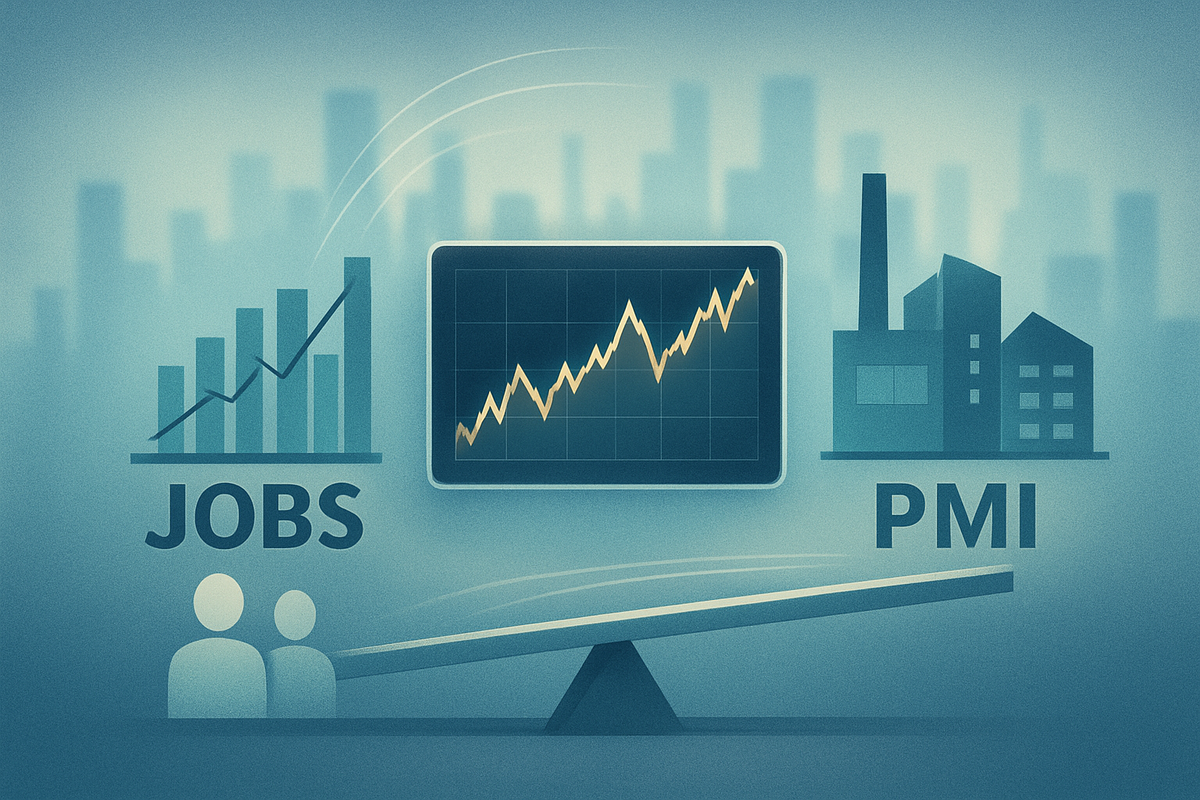Economic Crossroads: How Key Indicators Are Steering the Stock Market Through Moderation and Policy Shifts

The financial markets are currently navigating a complex and often contradictory economic landscape, heavily influenced by a suite of critical indicators such as jobs data and the Purchasing Managers' Index (PMI). From late 2024 through November 2025, these barometers of economic health have signaled a period of deliberate rebalancing, characterized by a softening labor market, persistent contraction in manufacturing, but a surprising resilience in the services sector. This intricate dance of data points has profound implications for investor sentiment, corporate strategies, and the trajectory of monetary policy, shaping the immediate and long-term direction of the stock market.
Investors, analysts, and policymakers are meticulously scrutinizing every new data release, as these figures not only paint a picture of the economy's current state but also provide crucial foresight into future trends. The ongoing shifts in these indicators are compelling market participants to reassess valuations, recalibrate growth expectations, and brace for potential strategic pivots, making the understanding of their influence more critical than ever for a general financial audience.
A Deep Dive into Recent Economic Indicator Trends: Late 2024 - November 2025
The period spanning late 2024 to November 2025 has been a crucible for the U.S. economy, marked by a gradual cooling in the labor market and a divergence in performance between the manufacturing and services sectors. These trends, alongside the Federal Reserve's (Fed) policy shifts, have significantly impacted market dynamics.
Jobs Data: A Moderating Labor Market
The labor market, a cornerstone of economic health, showed clear signs of moderation. Non-Farm Payrolls (NFP) exhibited a significant deceleration in job creation. Notably, preliminary benchmark revisions in September 2025 indicated that the U.S. economy added 911,000 fewer jobs in the 12 months through March 2025 than initially reported—the largest downward revision since at least 2000. This suggested the labor market entered 2025 with considerably less momentum than previously perceived.
Monthly NFP figures reflected this cooling: December 2024 saw a robust 256,000 increase, but January 2025's 143,000 fell short of expectations. Subsequent months often saw downward revisions to prior data, culminating in a modest gain of only 22,000 in August 2025, significantly below forecasts.
The unemployment rate mirrored this trend, gradually ticking up. After narrowing to 4.1% in December 2024, it edged down to 4.0% in January 2025 before rising to 4.2% in July and further to 4.3% in August 2025, reaching its highest level since October 2021. This indicated a softening of labor demand.
Wage growth, as measured by Average Hourly Earnings, also showed signs of deceleration. While January 2025 saw a 4.1% year-over-year (YoY) increase, by August 2025, it moderated to 3.7% YoY. Real average hourly earnings even decreased by 0.1% from July to August, seasonally adjusted, suggesting that while nominal wages grew, their purchasing power was being eroded.
Purchasing Managers' Index (PMI): A Tale of Two Sectors
The PMI data presented a stark contrast between the goods-producing and services sectors.
The Manufacturing PMI consistently signaled contraction for an extended period. The ISM Manufacturing PMI, a key indicator, registered 48.7% in October 2025, marking the eighth consecutive month of contraction. This weakness was characterized by declining new orders, reduced production, and falling employment, reflecting subdued demand and inventory adjustments. Tariffs were frequently cited as a contributing factor to this downturn.
Conversely, the Services PMI demonstrated remarkable resilience. The ISM Services PMI rose to 52.4% in October 2025, beating forecasts and indicating the strongest expansion in the services sector since February. This growth was driven by robust rebounds in business activity and new orders, although employment in the services sector continued to contract marginally or showed easing rates of contraction. This resilience provided a crucial buffer for overall economic growth.
Market Reactions: Market participants reacted swiftly to these data points. Stronger-than-expected jobs reports, such as December 2024's NFP, often led to a boost in the U.S. dollar and, at times, pressure on equity markets as expectations for Fed rate cuts diminished. Conversely, weaker data, like the August 2025 NFP, fueled expectations of earlier monetary easing, often supporting stock indices. The significant downward revisions to historical NFP data in September 2025 were particularly impactful, suggesting a weaker labor market than previously understood and influencing the Fed's dovish pivot. Similarly, PMI data, especially the Services PMI, provided directional cues, with strong readings generally fostering optimism and weak readings raising concerns about corporate earnings and economic momentum.
Companies and Sectors: Winners and Losers in a Moderating Economy
The nuanced economic environment from late 2024 to November 2025, characterized by a cooling labor market, manufacturing contraction, and services resilience, has created a distinct set of winners and losers across various sectors. Companies with lower interest rate sensitivity, robust demand for essential goods or services, and those benefiting from strategic technological shifts are poised to outperform, while those reliant on discretionary spending or facing manufacturing headwinds are likely to struggle.
Sectors and Companies Likely to Win:
- Technology (AI-driven and Enterprise Software/Services): Despite broader economic moderation, investment in Artificial Intelligence (AI) remains a powerful driver. Companies at the forefront of AI development and those providing essential enterprise software and cloud services are thriving. Lower interest rates also make future growth prospects more attractive for tech firms often reliant on financing.
- NVIDIA (NASDAQ: NVDA): As a leader in GPUs crucial for AI, it benefits from significant capital expenditure in data centers.
- Microsoft (NASDAQ: MSFT): Its strong position in cloud computing and enterprise software, heavily integrated with AI, ensures sustained demand.
- Modine Manufacturing (NYSE: MOD): Its specialized temperature management systems for AI data centers have seen increased demand.
- Constellation Energy (NASDAQ: CEG): Supplying nuclear power to data centers, it benefits from the immense energy needs of AI infrastructure.
- Healthcare (Non-Discretionary Services and Products): Demand for essential healthcare services and products remains stable regardless of economic fluctuations. An aging population and ongoing innovation provide long-term growth drivers.
- Abbott Laboratories (NYSE: ABT): Diversified in essential medical devices, diagnostics, and nutritionals.
- Quest Diagnostics (NYSE: DGX): A major provider of non-discretionary diagnostic testing.
- DaVita Inc. (NYSE: DVA): Provides critical and recurring kidney dialysis services.
- Consumer Staples (Discount Retailers and Essential Goods): With moderating wage growth and slightly rising unemployment, consumers prioritize essential goods and seek value, benefiting discount retailers and producers of everyday necessities.
- Walmart (NYSE: WMT) and Costco Wholesale (NASDAQ: COST): These retailers often see increased traffic during economic slowdowns.
- PepsiCo Inc. (NASDAQ: PEP): Benefits from stable demand for its wide range of essential food and beverage products.
- Dollar General (NYSE: DG) / Dollar Tree (NASDAQ: DLTR): Deep discount retailers that typically thrive when consumers tighten their belts.
- Utilities: Considered a defensive sector, demand for electricity and gas is relatively inelastic. The increasing power demands of AI data centers also create new demand sources.
- NextEra Energy (NYSE: NEE): A large utility provider investing heavily in renewable energy, benefiting from stable demand and infrastructure spending.
Sectors and Companies Likely to Lose:
- Manufacturing/Industrial (Especially Durable Goods): The manufacturing sector's sustained contraction, marked by falling new orders and reduced production, directly impacts companies producing goods, especially durable items.
- General Motors (NYSE: GM) / Ford Motor Company (NYSE: F): Auto manufacturers are highly sensitive to consumer confidence and big-ticket purchases, which are slowing.
- Whirlpool Corporation (NYSE: WHR): Faces reduced demand for major appliances and other durable consumer goods.
- Caterpillar Inc. (NYSE: CAT): Its industrial and construction machinery sales are impacted by manufacturing slowdowns and reduced business investment.
- Consumer Discretionary (Luxury Goods, Restaurants, Travel & Leisure): Moderating wage growth and cautious consumer spending directly impact discretionary purchases, particularly high-end items and experiences.
- Starbucks Corporation (NASDAQ: SBUX): Discretionary spending on premium coffee and dining can be affected by tightening consumer budgets.
- Marriott International (NASDAQ: MAR) / Hilton Worldwide Holdings (NYSE: HLT): While travel has shown resilience, a significant slowdown in discretionary spending could impact leisure travel and higher-end hospitality.
- Darden Restaurants (NYSE: DRI): Operates full-service restaurant chains sensitive to consumer discretionary spending.
- Construction and Real Estate: Highly sensitive to interest rates, the sector has been impacted by elevated borrowing costs through late 2024 and into 2025, slowing new building projects.
- Lennar Corporation (NYSE: LEN) / D.R. Horton (NYSE: DHI): Homebuilders are directly impacted by mortgage rates and buyer affordability.
- Prologis, Inc. (NYSE: PLD): An industrial REIT that could face headwinds if manufacturing contraction reduces demand for warehouse and logistics space.
- Transportation and Logistics: A contraction in manufacturing and a slowdown in goods demand directly impacts the volume of freight needing to be transported.
- FedEx Corporation (NYSE: FDX) / United Parcel Service (NYSE: UPS): Global logistics companies highly sensitive to overall economic activity and goods movement.
Wider Significance: A Rebalancing Act Amidst Global Headwinds
The economic trends observed from late 2024 to November 2025 carry significant broader implications, painting a picture of an economy in a delicate rebalancing act. These trends fit into larger industry dynamics, create ripple effects across global markets, and heavily influence regulatory and monetary policy decisions.
Broader Industry Trends: Disinflation and Labor Market Rebalancing
The moderating jobs data and slowing wage growth are significant contributors to disinflationary pressures. Headline Consumer Price Index (CPI) inflation stood at 3.0% YoY in September 2025, with core CPI at 3.1%. While still above the Federal Reserve's 2% target, the pace of inflation had moderated significantly from earlier highs. This progress towards disinflation, however, was not without caveats, as economists cautioned that progress might stall in 2025 due to expected changes in trade, fiscal, and immigration policies, with tariffs being a key factor potentially leading to higher inflation, particularly in the goods sector.
The labor market was clearly undergoing rebalancing, moving away from the extreme tightness of previous years. The combination of slowing job creation, an uptick in unemployment, and moderating wage growth signaled that labor supply and demand were coming into a more sustainable equilibrium. This "low-hire, low-fire" environment, characterized by companies being less aggressive in hiring but also avoiding widespread layoffs, was considered crucial for achieving lower inflation without necessarily triggering a severe recession.
Potential Ripple Effects: Trade Tensions and Global Slowdown
The economic moderation in the U.S., particularly the manufacturing contraction, had ripple effects on competitors and partners. Diminished U.S. consumer confidence in late 2025 was expected to lead to reduced consumer spending and investment, impacting sectors globally that rely on U.S. demand. The ongoing impact of tariffs was a significant factor, contributing to falling manufacturing exports and limiting business confidence. This created uncertainty for trading partners and could lead to increased production costs globally, potentially sparking retaliatory tariffs and harming U.S. exports. The overall moderation in U.S. growth also contributed to a broader global economic slowdown, affecting countries integrated into global supply chains.
Regulatory or Policy Implications: The Fed's Pivotal Role
The moderating jobs data and slowing wage growth solidified expectations for continued interest rate cuts by the Federal Reserve. The Fed had already initiated cuts in late 2024 and again in October 2025, bringing the federal funds rate to between 3.75% and 4.0%. Further easing was anticipated into 2026 as the Fed prioritized supporting employment amidst persistent inflation. The Fed's dual mandate of maximum employment and price stability heavily relies on these labor market reports. However, the Fed's September 2025 projection for the unemployment rate at 4.5% by year-end indicated ongoing concern about negative labor market momentum.
Historical Precedents and Comparisons:
The "low-hire, low-fire" labor market observed in 2024-2025 has been described as a "curious balance," making it somewhat unique. This period represented an attempt to rebalance the labor market and reduce inflation without triggering a recession, a path not always achieved in previous cycles. The significant downward revision of job numbers (911,000 fewer jobs through March 2025) was the largest since at least 2000, underscoring the unusual nature of the economic shifts. This suggests that while there are parallels to periods of moderating growth and disinflation, the specific confluence of factors—including post-pandemic supply chain healing, evolving trade policies, and immigration impacts on labor supply—created a distinct economic environment.
What Comes Next: Navigating the Path Ahead
The economic landscape from late 2025 onward is poised for continued evolution, shaped by the interplay of moderating economic indicators, ongoing Federal Reserve policy, and persistent global uncertainties. While a "soft landing" remains a central possibility, businesses and investors must prepare for a range of scenarios and adapt strategically.
Short-Term and Long-Term Possibilities:
In the short-term (late 2025 - early 2026), expect continued economic moderation in the U.S., influenced by cooling labor markets and the lingering impact of tariffs. The Federal Reserve's rate cuts, initiated in late 2024 and continuing into 2025, are intended to support economic growth and stabilize the labor market. However, U.S. inflation is projected to remain above target, potentially reaccelerating due to tariff-induced price hikes, which could lead to increased market volatility amidst policy uncertainty.
For the long-term (mid-2026 onward), the global economy is expected to continue growing at a subdued pace, hampered by challenges such as an aging workforce and China's slowdown. Higher tariffs and trade policy uncertainty are anticipated to weigh on U.S. real GDP growth, with consumers bearing the brunt of higher prices. While global inflation is expected to decline, the U.S. might experience more stubborn inflation. Central banks globally are likely to continue easing monetary policy, which could support a moderate economic recovery.
Potential Strategic Pivots and Adaptations for Businesses:
Businesses must adopt agile strategies to navigate this environment:
- Supply Chain Diversification and Reshoring: Geopolitical tensions and aggressive tariff policies necessitate diversifying supplier networks and shortening supply chains.
- Cost Management and Financial Resilience: Optimizing operations, rigorous financial review, and building cash reserves are crucial.
- Customer Focus and Service Excellence: In a cautious spending environment, strong customer relationships and high-level service are paramount.
- Technological Adoption and AI Integration: Investing in digital transformation, automation, and AI can improve productivity and create a competitive advantage.
- Workforce Development: Rethinking recruitment, training, and retention policies is vital to address skills shortages and changing employment expectations.
Market Opportunities and Challenges:
Opportunities may emerge in diversification beyond U.S. mega-cap technology stocks, with cyclical and value-style investments gaining traction. Fixed-income markets, particularly investment-grade and short-maturity high-yield credit, may outperform cash as Fed rate cuts drive cash yields below bond yields. Private markets and infrastructure also present attractive investment opportunities. Emerging markets, especially in Asia, are expected to continue offering a growth premium.
Challenges include potentially high valuations in public markets, making it difficult to find attractive entry points. Policy uncertainty, ongoing tariff volatility, and escalating geopolitical risks will create an unstable environment. Stubborn U.S. inflation might lead to less aggressive rate cuts from the Fed, and a deceleration in economic growth could result in slowing corporate earnings.
Potential Scenarios and Outcomes:
- Soft Landing (Base Case): Inflation moves lower while the economy remains robust and unemployment stays low. Many economists assign a high probability (e.g., Wells Fargo 42%, Standard Chartered 60%) to this outcome, assuming limited tariffs and a mild U.S. slowdown followed by recovery.
- "No Landing" Scenario: The economy remains strong, but inflationary pressures persist, forcing the Fed to keep interest rates elevated, potentially exacerbated by higher tariffs.
- Shallow Recession / Demand-Led Recession: Some forecasts indicate a significant probability (e.g., J.P. Morgan 60% by end of 2025, Deloitte 40% over 12 months) of a demand-led recession, where rising uncertainty causes consumer confidence to drop, partly due to aggressive tariff policies.
- Trade Wars Scenario: High tariffs are met with retaliation, leading to a global trade war, severe global growth slowdown, and potentially a U.S. recession with rising prices.
Comprehensive Wrap-up: Navigating the New Economic Normal
The period from late 2024 to November 2025 has been a testament to the dynamic interplay between economic indicators, monetary policy, and global events.
Summary of Key Takeaways:
The labor market has clearly rebalanced, moving from extreme tightness to a more sustainable equilibrium with slowing job creation and a slight uptick in unemployment. This, coupled with moderating wage growth, has contributed significantly to disinflation. However, manufacturing has endured a prolonged contraction, largely due to subdued demand and the disruptive force of tariffs. In contrast, the services sector has shown remarkable resilience, acting as a crucial buffer for overall economic growth. Against this backdrop, the Federal Reserve has pivoted to monetary easing, initiating rate cuts to support employment while carefully managing persistent, albeit moderating, inflation.
Assessment of the Market Moving Forward:
The prevailing hope for a soft landing—where inflation cools without a significant recession—remains a strong possibility, supported by the Fed's strategic rate cuts. However, the path is not without its challenges. The "no landing" scenario, characterized by persistent inflation despite economic strength, and the possibility of a shallow, demand-led recession, particularly if tariff policies intensify, remain credible alternative outcomes. The significant downward revisions to historical job data underscore the underlying fragility that was perhaps masked by earlier, more optimistic figures. The market will likely continue to exhibit volatility as it processes these mixed signals and adjusts to evolving policy.
Final Thoughts on Significance and Lasting Impact:
This era signifies a recalibration of economic growth expectations to a more moderate pace, moving away from the immediate post-pandemic boom. It has highlighted the Federal Reserve's commitment to its dual mandate, demonstrating its willingness to ease monetary policy to support employment as inflation moderates. Crucially, the period has underscored the growing influence of geopolitical factors and trade policies, particularly tariffs, which have demonstrably impacted manufacturing and overall GDP growth. This complex environment also brings to the fore the accelerating impact of technological advancements like AI on productivity and labor market dynamics, suggesting ongoing structural shifts that will redefine economic competitiveness.
What Investors Should Watch For in Coming Months:
Investors must remain vigilant and strategically adaptive. Key areas of focus include:
- Economic Data:
- Inflation Rates (CPI & PPI): Monitor both headline and core inflation closely for sustained movement towards the Fed's 2% target.
- Labor Market Reports: Pay attention to NFP, unemployment rate, and especially wage growth data, along with any significant revisions.
- Manufacturing and Services PMIs: Watch for signs of a rebound in manufacturing or any significant weakening in services, which would be crucial directional indicators.
- Consumer Confidence and Spending: These remain vital for assessing the health of consumer demand.
- Policy Decisions:
- Federal Reserve Monetary Policy: Closely follow FOMC statements and speeches for cues on future interest rate decisions and the Fed's evolving outlook on inflation and employment.
- Fiscal and Trade Policies: Given the impact of tariffs, future trade policies and government spending initiatives will significantly influence economic growth and corporate earnings.
- Market Signals:
- Corporate Earnings and Guidance: These will provide granular insights into how economic trends are affecting specific sectors and businesses.
- Bond Market (Yield Curve): The shape of the yield curve and movements in bond yields, particularly the 10-year Treasury, can signal market expectations for growth and inflation.
- Credit Conditions: Monitor lending standards and credit availability, as tightening credit can restrict business investment and consumer spending.
- Equity Market Volatility and Sector Performance: Increased volatility and shifts in leadership among sectors will indicate changes in investor sentiment and economic outlooks. Focus on diversified portfolios and companies with solid fundamentals.
This content is intended for informational purposes only and is not financial advice



